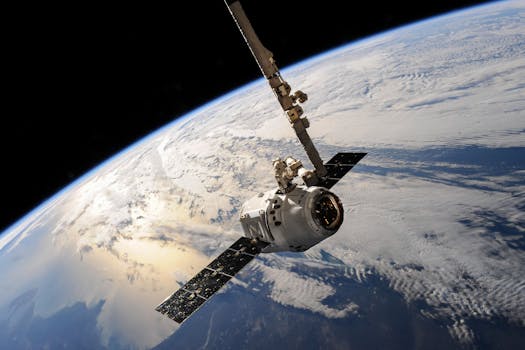GEO satellites, or Geostationary satellites, are a type of satellite that orbits the Earth at an altitude of approximately 36,000 kilometers, remaining stationary relative to a fixed point on the equator. GEO satellites have been a cornerstone of modern telecommunications, providing a wide range of services including television broadcasting, telecommunications, and weather forecasting. The focus keyword for this article is GEO satellites, and we will explore their history, applications, and future developments.
The first GEO satellite was launched in 1963, and since then, hundreds of satellites have been deployed in geostationary orbit. These satellites have enabled global connectivity, facilitating communication between different parts of the world. GEO satellites have also played a crucial role in navigation, with systems like GPS relying on a network of satellites in medium Earth orbit, but also using GEO satellites for augmentation and backup.
In terms of applications, GEO satellites are used for a variety of purposes. They provide television broadcasting services, enabling people around the world to access a wide range of channels and programs. They also provide telecommunications services, including voice, data, and internet connectivity. Additionally, GEO satellites are used for weather forecasting, providing critical data and imagery for meteorological agencies and research institutions.
GEO satellites have also enabled remote sensing applications, such as earth observation and environmental monitoring. These satellites can capture high-resolution images of the Earth’s surface, providing valuable data for applications like agriculture, forestry, and disaster management. Furthermore, GEO satellites have been used for scientific research, including astronomy and space weather monitoring.
Despite the many benefits of GEO satellites, there are also challenges associated with their deployment and operation. One of the main challenges is the risk of collisions with other satellites or space debris. This risk is mitigated through careful planning and coordination, as well as the use of advanced technologies like collision avoidance systems. Another challenge is the limited availability of spectrum, which can limit the number of satellites that can be deployed in geostationary orbit.
Looking to the future, GEO satellites are likely to continue playing a vital role in global connectivity and a wide range of applications. Next-generation satellites will offer higher throughput, greater flexibility, and improved performance. They will also enable new services and applications, such as 5G connectivity, IoT, and precision agriculture. Additionally, GEO satellites will be used for deep space missions, providing critical communication and navigation services for astronauts and spacecraft.
In conclusion, GEO satellites have revolutionized the way we communicate, navigate, and understand our planet. They have enabled global connectivity, facilitated remote sensing applications, and provided critical services for a wide range of industries. As we look to the future, it is clear that GEO satellites will continue to play a vital role in shaping our world and enabling new technologies and applications.
The development and deployment of GEO satellites have also had a significant impact on the environment. The launch of satellites into orbit has contributed to the growing problem of space debris, which poses a risk to operational satellites and other spacecraft. Additionally, the production and disposal of satellites have environmental implications, including the use of resources and the generation of waste.
However, the benefits of GEO satellites far outweigh the costs. They have enabled global connectivity, facilitated international communication and cooperation, and provided critical services for a wide range of industries. They have also enabled remote sensing applications, which have improved our understanding of the Earth’s environment and natural resources.
In terms of the future of GEO satellites, there are many exciting developments on the horizon. Next-generation satellites will offer higher throughput, greater flexibility, and improved performance. They will also enable new services and applications, such as 5G connectivity, IoT, and precision agriculture. Additionally, GEO satellites will be used for deep space missions, providing critical communication and navigation services for astronauts and spacecraft.
One of the most significant trends in the GEO satellite industry is the development of reusable launch vehicles. These vehicles will enable the cost-effective launch of satellites into orbit, reducing the financial burden on satellite operators and enabling the deployment of more satellites. Additionally, reusable launch vehicles will reduce the environmental impact of satellite launches, minimizing the amount of waste generated and the risk of accidents.
Another trend in the GEO satellite industry is the development of small satellites. These satellites are smaller, cheaper, and more agile than traditional satellites, enabling the deployment of constellations of satellites that can provide global coverage and high-resolution imagery. Small satellites will also enable new services and applications, such as IoT and precision agriculture, and will provide critical services for a wide range of industries.
In conclusion, GEO satellites have played a vital role in shaping our world and enabling global connectivity. They have facilitated remote sensing applications, provided critical services for a wide range of industries, and enabled international communication and cooperation. As we look to the future, it is clear that GEO satellites will continue to play a vital role in enabling new technologies and applications, and will remain a cornerstone of modern telecommunications.
The GEO satellite industry is expected to continue growing in the coming years, with new developments and innovations on the horizon. The increasing demand for global connectivity, remote sensing applications, and critical services will drive the deployment of more satellites, and the development of new technologies and applications. Additionally, the growing trend of small satellites and reusable launch vehicles will reduce the cost and environmental impact of satellite launches, enabling the deployment of more satellites and the provision of critical services for a wide range of industries.
However, the GEO satellite industry also faces challenges and risks. The increasing amount of space debris in orbit poses a risk to operational satellites and other spacecraft, and the production and disposal of satellites have environmental implications. Additionally, the risk of collisions with other satellites or space debris is a significant concern, and the limited availability of spectrum can limit the number of satellites that can be deployed in geostationary orbit.
Despite these challenges and risks, the benefits of GEO satellites far outweigh the costs. They have enabled global connectivity, facilitated international communication and cooperation, and provided critical services for a wide range of industries. They have also enabled remote sensing applications, which have improved our understanding of the Earth’s environment and natural resources.
In terms of the environmental impact of GEO satellites, there are several factors to consider. The production and disposal of satellites have environmental implications, including the use of resources and the generation of waste. Additionally, the launch of satellites into orbit has contributed to the growing problem of space debris, which poses a risk to operational satellites and other spacecraft.
However, the benefits of GEO satellites far outweigh the costs. They have enabled global connectivity, facilitated international communication and cooperation, and provided critical services for a wide range of industries. They have also enabled remote sensing applications, which have improved our understanding of the Earth’s environment and natural resources.
The development and deployment of GEO satellites have also had a significant impact on the economy. The satellite industry is a major contributor to the global economy, providing employment opportunities and generating revenue. Additionally, the services provided by GEO satellites have enabled the growth of a wide range of industries, including telecommunications, navigation, and remote sensing.
In conclusion, GEO satellites have played a vital role in shaping our world and enabling global connectivity. They have facilitated remote sensing applications, provided critical services for a wide range of industries, and enabled international communication and cooperation. As we look to the future, it is clear that GEO satellites will continue to play a vital role in enabling new technologies and applications, and will remain a cornerstone of modern telecommunications.
The future of GEO satellites is exciting and full of possibilities. Next-generation satellites will offer higher throughput, greater flexibility, and improved performance. They will also enable new services and applications, such as 5G connectivity, IoT, and precision agriculture. Additionally, GEO satellites will be used for deep space missions, providing critical communication and navigation services for astronauts and spacecraft.
The development and deployment of GEO satellites will also have a significant impact on the environment. The production and disposal of satellites have environmental implications, including the use of resources and the generation of waste. Additionally, the launch of satellites into orbit has contributed to the growing problem of space debris, which poses a risk to operational satellites and other spacecraft.
However, the benefits of GEO satellites far outweigh the costs. They have enabled global connectivity, facilitated international communication and cooperation, and provided critical services for a wide range of industries. They have also enabled remote sensing applications, which have improved our understanding of the Earth’s environment and natural resources.
In terms of the future of the GEO satellite industry, there are many exciting developments on the horizon. The increasing demand for global connectivity, remote sensing applications, and critical services will drive the deployment of more satellites, and the development of new technologies and applications. Additionally, the growing trend of small satellites and reusable launch vehicles will reduce the cost and environmental impact of satellite launches, enabling the deployment of more satellites and the provision of critical services for a wide range of industries.
The GEO satellite industry is expected to continue growing in the coming years, with new developments and innovations on the horizon. The increasing demand for global connectivity, remote sensing applications, and critical services will drive the deployment of more satellites, and the development of new technologies and applications.
In conclusion, GEO satellites have played a vital role in shaping our world and enabling global connectivity. They have facilitated remote sensing applications, provided critical services for a wide range of industries, and enabled international communication and cooperation. As we look to the future, it is clear that GEO satellites will continue to play a vital role in enabling new technologies and applications, and will remain a cornerstone of modern telecommunications.

